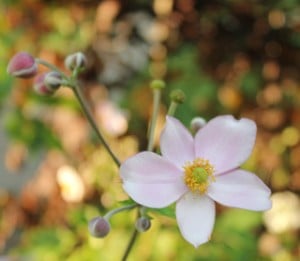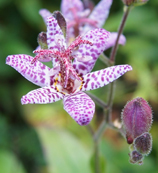Days are still hot. Roses and tomatoes are still around. But I can’t avoid knowing that fall is on the way, because its lovely, wistful heralds are flowering—Japanese anemones and turtlehead, with toad lilies on the way.
Gardeners tell time by what’s in bloom, and these plants remind me that it’s time to start thinking about moving the houseplants into the house or the greenhouse. I love the way these perennials extend the season of bloom in my shady garden; the price I pay is that they remind me frosty nights are only six weeks away.

The Japanese anemones (Anemone hupehensis) start blooming in August and keep it up through September. Their five-petalled pale pink flowers nod elegantly on tall stems, up to 4 feet tall, above a big mass of maple-leaf-like foliage.
The anemones may appear delicate, but I’ve come to know this plant as a bare-knuckle fighter that will expand and out-muscle other plants. I regularly divide it to keep it within bounds, so now I have several clumps, blooming even in what I think of as my deepest shade.
Turtlehead is a native plant that grows in moist places—stream banks or wet woodlands. Its 2- to 3-foot stalks have bundles of tube-like flowers that do look sort of like the face on a particularly winsome turtle. A few days ago I was amused to watch a fat bumblebee collecting pollen from a patch of turtlehead. She would practically disappear into each flower, with only her fuzzy bottom sticking out.
I have two kinds of turtlehead: Chelone obliqua has pink flowers and blooms earlier, in late July and August, and Chelone glabra has white flowers that come later, in September and October. Both do well in considerable shade in my garden.
Later in fall, after leaves are falling, when even the anemones are fading away, another twinkle of bloom will appear: the toad lilies. They have small purple flowers with white speckles, shaped like miniature daylilies, clustered along 3- to 4-foot-tall stems. The blooming doesn’t start until mid-September, but it keeps going until frost.

The plants need shade and thrive there, forming thick clumps. My plants are Tricyrtis formosana, but there are a number of species. The Chicago Botanic Garden did a good evaluation of them a few years ago.
Toad lilies—I guess they get their moniker from the speckles—are dear to me because they are the last brave bloomers. I have them planted by the walk where I can easily appreciate their charm each year as red and gold leaves fall all around.


